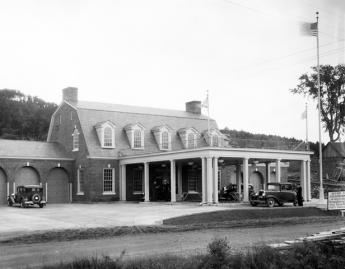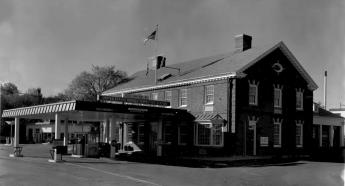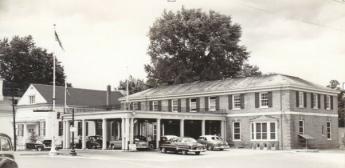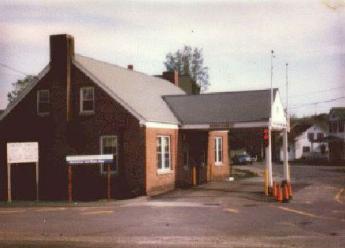Protecting our nation’s gateways
Our nation’s Land Ports of Entry not only act as the entryway to our country but a gateway into American history. The dozens of brick, steel, and wooden structures that line the border between the United States and Canada tell a story of years past.
The preservation of the country’s historic buildings and properties began following the passage of the National Historic Preservation Act of 1966 (NHPA).
The purpose of this legislation, specifically Section 106 of the NHPA, is to hold each federal agency accountable for identifying and assessing “the effects its actions may have on historic buildings.”
It takes a village to ensure that each renovation or project complies with the requirements. From the U.S. General Services Administration’s (GSA) project managers to property managers to the regional historic preservation officers, each person has a role in maintaining our land ports of entry.
In complying with the statutes which apply to all federal agencies, it is vital that GSA work to preserve the historic appeal of these buildings while also propelling them into modern times with updated technology, security, and infrastructure.
Recent funding from the Bipartisan Infrastructure Investment and Jobs Acts will allow many of these historic ports to undergo renovations as a way to maintain their history but assist the occupants in their 21st century mission.
With the constant need for renovations to our oldest facilities, it is even more important to understand how and why we preserve these historic ports.
Renovations to any facilities or buildings listed or eligible for listing in the National Register of Historic Places must follow specific guidelines.
Our Historic Ports
The New England Region has approximately 21 land ports of entry, border stations, and border station garages that are either listed or are eligible for the National Register of Historic Places - 7 in Maine and 14 in Vermont While some of them have received or will receive renovations in the future, most of them remain as close to their original design as possible.
- U.S. Border Station, Beecher Falls

The station at Beecher Falls, constructed in 1932, is among the earliest and best preserved of the group of stations constructed in the 1930s, and was operational prior to repeal of Prohibition. This group of stations, constructed in response to Vermont’s improved road linkage with Canada and enforcement of the federal Volstead Act, were designed by the Office of the Supervising Architect of the Treasury.
Beyond projecting an iconographic image of American architecture at the international border, the border station is one of the major masonry public buildings located in the town of Beecher Falls. This handsome Georgian Revival building is a gambrel-roofed, two-story brick structure flanked by hip-roofed, one-story brick garage wings. It retains most of its original character-defining features, including morphology, plan, masonry detailing and fenestration.
- Ferry Point-Calais

This border station, constructed in 1935, connects the towns of Calais, Maine and St. Stephen, New Brunswick Canada. This border station was built following a push by the federal government in the late 1920s for greater control over our borders as automobiles became popular. The main building is a two and a half-story brick structure with Colonial Revival style, from which a two-lane metal porte-cochere extends. The Ferry Point-Calais border station has received $38.5 million for repair and alterations utilizing the money approved by Congress and signed by President Biden under the Bipartisan Infrastructure Deal.
- Derby Line Rte, 5 LPOE

The Vermont border station located within the town of Derby Line is one of twelve surviving complexes erected between 1931 and 1937 along the Vermont-Quebec border. It occupies a 68,431 square foot site on the west side of U.S. Route 5, or Main Street, several hundred feet south of the Canadian border. The Georgian revival-style border station is a major visual element in the center of the village of Derby Line, located next to the village hall and across from a mixed residential and commercial block. This station, alongside a group of others, was part of the extensive rebuilding of Vermont’s road system following the Great Flood of November 3, 1927. The station at Derby Line was among the first to open and was the largest.
- U.S. Border Station, Beebe Plain

While the Derby Line station was the first to open following the construction of a group of border stations in the 1930s, the Beebe Plain station was among the last to be constructed. Built in 1937, Beebe exemplifies the simplification of design and economy of material brought about by the Depression while continuing many of the programmatic elements of the earlier stations. The station is one of a few located in an urban cluster, and the only station from this period located on the east side of the highway. The Beebe Plain Border Station is set to undergo a $29.3 million expansion utilizing the money approved by Congress and signed by President Biden under the Bipartisan Infrastructure Deal.
These stations are ingrained into the surrounding communities and the culture and heritage of the people that live there. They have acted not only as a literal gateway to our bordering Canadian neighbors to the north but a doorway to a shared respect between two nations. With many tourists as well as local citizens traveling between the bordering cities and towns it is important we preserve these historic facilities as a reminder of how our land ports of entry play a part in our local border communities.

 U.S. General Services Administration
U.S. General Services Administration